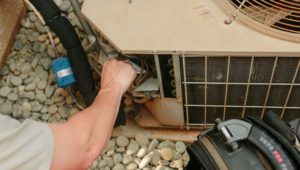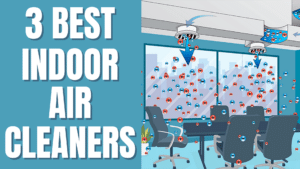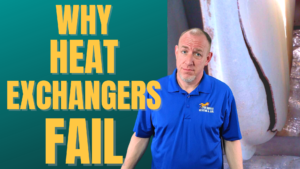The global warming potential of R410 is leading to the use of flammable refrigerants for indoor comfort
With the complete phase-out of R410A already underway, the industry is looking for new alternatives. These alternatives are required by the Kigali amendment to the Montreal Protocol to start using a refrigerant that not only has no ozone-depleting potential, but significantly lower global warming potential.
Ozone-Depleting Potential
R-22 refrigerant (freon) is a Chlorodifluoromethane that has ozone-depleting potential. As it escapes a refrigerant system, chlorine is released with R22. It’s been proven several times over that freon escaping into the air gets carried to the stratosphere with updrafts. Once high enough, the freon bonds break down when UV rays from the sun hit them, releasing the chlorine from its bond where it lingers in the ozone layer for years.
The California Air Resource Board says, “releasing one 30 lb. jug of R22 is more potent, if released, than the CO2 emitted to the air by driving nearly 7 more fossil-fuel-powered cars each year.” Not only that but its global warming potential (GWP) is 1810. That means R22 released into the air has 1800 times the potency as the same amount of carbon dioxide.
Just as a reminder, we all know CO2 is a once naturally-occurring greenhouse gas that has significantly increased since the late 1700s with the start of the Industrial Revolution. Humans and their machines have elevated once balanced CO2 levels to almost twice what it was. What once was a normal amount of CO2 in our atmosphere, helpfully trapping heat in our atmosphere, has now risen far beyond normal. This contributes to an abnormal rate of global warming.
As for R410A refrigerant, while it has no ozone-depleting potential, it does have a significant amount of global warming potential. Would you be surprised to know that its GWP is even higher than R22’s, at a little over 2000?
Legislation
This has led to Kigali mandating the HVAC industry to elevate its standards for refrigerant usage in residential and commercial systems. Further, the state of California has passed legislation requiring the phase-out of what most of us thought to be the “environmentally-friendly” refrigerants (R-410a, R-134, etc.) by the year 2023.
And if HVAC manufacturers have to change the refrigerants to satisfy the state of California, they likely will have to change the refrigerants in all the equipment they sell throughout the entire United States and elsewhere. It makes no sense for these companies to manufacture two different types of equipment lines.
Future Alternatives
So, what refrigerants would we move to? Well, they’re already being used in HVAC applications today. Actually, since 2012, R32 is a refrigerant that Daikin has been using as its non-ozone depleting refrigerant with very low GWP.
Carrier also has one called R454B. The other name for it, Puron Advanced, is strangely familiar to us all. It implies ozone-depleting and easy to switch to. Carrier has already declared by 2023 that all their ducted air conditioning products in North America will be manufactured with this product.
But most of us who have been following the phaseout of R410A are concerned about the composition of these refrigerants. Put in the category of “Mildly Flammable,” these refrigerants are listed as A2L refrigerants.
Mildly Flammable? As opposed to what? R22 and R410A are considered to have low flammability levels and are listed as A1. A and B are the toxicity levels of the refrigerant; “A” being lower than “B”, while 1,2 and 3 are the flammability ratings, with 1 being the lowest and 3 being the highest.
What is Mildly Flammable?
According to an article written for the Department of Energy Technology, author Pavel Makhnatch described a comparison as to what Mildly Flammable means. “To be deemed a mildly flammable refrigerant, a substance must burn at a velocity no greater than 10 square meters per second. By comparison, Usain Bolt’s world record 100-meter time equates to 1043 square meters per second, while hydrocarbons burn many times faster,” Makhnatch said.
R32 is described as having a lower flammability rating than ammonia which is already known for being a difficult substance to ignite. That makes me feel all warm and cozy, but when ACHR News and Indoor Comfort News started releasing stories about the dangers that could arise when switching over to an A2L refrigerant, it made my ears perk up.
One article I read said we technicians will have to switch to recovery machines that vacate any accumulating nearby fumes. Machines that have a source of ignition like something as little as a spark. I realize I don’t fully understand the mechanical breakdown of a recovery machine or vacuum pump, but I do realize they need electricity to run. The article I read reports that most common recovery machines won’t be suitable for A2L refrigerants.
Another concern of mine and many others is “mildly flammable” still means more flammable than non-flammable.
Upcoming Code Changes
The International Code Council recently met and discussed routine changes to the upcoming code. These changes rarely make as big of an impact on the community as this topic does. Usually they just change some wording for new emerging technologies. But Jay Peters for Indoor Comfort News wrote, “seldom does a standard update change the level of safety for a particular product, like the one happening with using flammable refrigerants.”
He’s concerned that the administration of the Code Council doesn’t really debate the technical aspects of the updated standard. Peters said, “the flammable refrigerants issue has become a very big subject of debate in the codes covering HVAC and fire safety nationwide.” He found that many proposals to add these refrigerants to direct in-home systems were all rejected.
Citing a deadline to get this new refrigerant mainstream, the companies are trying to get it pushed through to the International Code Council via the Fire Code, Mechanical Code and Residential Code. Well, no governmental agency is pushing them. This particular refrigerant is not mandated to be used by a certain time. It’s the companies themselves that are saying it.
Protection and Training for Flammable Refrigerants
These companies should be looking out for the real people who will be using it every day as well as those protecting us from it. HVAC mechanics and firefighters should be protected, fully trained, and prepared to handle and battle a potential fire breakout. This will require the International Fire Code, International Mechanical Code and the Uniform Mechanical Code to all get the facts to adopt the required wording for Mildly Flammable refrigerants.
Peters asks, “what will stop others from timing their standards the same way that has been done here – circumventing all technical and safety debate of the industry and the membership of the ICC? This sets a very bad precedent, raises safety concerns, and conflicts with the votes of the International Mechanical Code, Uniform Mechanical Code and International Fire Code committees.”
Jay Peters stresses to the ICC Membership that, “the committee must be overturned so that flammable refrigerants will not be allowed in homes without a single technical or safety provision in place to ensure public safety.”
Flammable Refrigerant in the Hands of Amateurs
My main concern when I heard all this wasn’t so much for our own technicians. I can train them! My concern is Side-job Bob, out on his first “mildly flammable refrigerant” call. Bob may seriously injure himself or causes major damage to the home he’s working on. Side-job Bob sure does take a lot of my business away, but I wouldn’t wish that on my worst enemy.
One refrigerant that does meet current non-flammable refrigerant ratings is Honeywell’s Solstice N41. R466A has no ozone-depleting potential and very low GWP. Even 65% less than R410A, Honeywell has partnered with Midea, China’s leading home appliance maker. They’re replacing R410A with Solstice N41 in HVAC applications. Honeywell has answered the the Kigali amendment mandate to produce a low GWP refrigerant. It’s also non-flammable which makes everyone safer for it.
It’s currently running in third place as the replacement for R410A. I feel this is due to its production cost. R32 is apparently cheaper to make than Honeywell’s R466A, which is a blend and therefore costs more to produce. Shutting out Solstice N41 just puts more money in the pockets of the big guys.
Are big companies like Daikin and Carrier willing to put people in danger to further pad their own pockets? It seems to me that they’re pressuring themselves to get this refrigerant out too quickly. Why? One, to beat everyone else to the punch, and two, to gain recognition and profits.
A Temporary Solution to Flammable Refrigerants
Daikin, Carrier and Honeywell all admit this refrigerant update is only a medium-term solution to the problem. Other refrigerants will be next as the drive to bring global warming potential to seemingly never-ending lows moves on.
Believe it or not, Daikin is already looking to replace their own R32 with a newer, lower GWP product. If that doesn’t chap your hide I don’t know what will. We just began the R410A phase-out. If R32 is truly our next refrigerant to be used, it’s already on its way out.
Flammable Refrigerants: Who is Most at Risk?
Let me know what you think in the comments below. Who pays the highest price by having to use an HVAC system that uses flammable refrigerant? Is it the technicians in the field, the HVAC company owners, or the end-user, the homeowner? There are more important things in life than money. There are lives at stake here, and I just hope the authorities get this one right.
Thanks so much for stopping by and we’ll see you on the next blog topic!




















